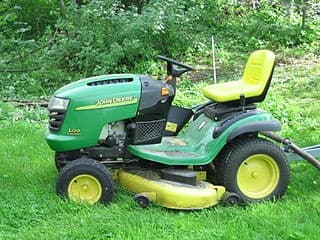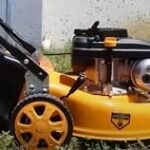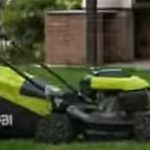As an Amazon Associate, this site earns commissions from qualifying purchases. For more information click here.
Some understanding of how lawn mowers function n can come in handy in case something goes wrong. One aspect that you may be wondering is if an alternator is required. That is what this post is about, to answer this question and explain other related facts. As you will see, the answer depends on what type of lawn mower you have.
Zero turn and rider lawn mowers have an alternator to charge their batteries. A push or walk behind lawn mower does not have an alternator even though they have a motor. Reel lawn mowers do not have an alternator either.
Which Lawn Mowers Have Alternators?
It depends on the lawn mower design. There are many types but the most popular are rider, reel and push/walk behind lawn mowers. You should always check the owner’s manual to be certain, but your mower should fall into any of the categories below. This will tell you if it has an alternator or not.
Walk Behind Lawn Mowers
There are two types of walk behind or push lawn mowers, gas and electric. Both do not use an alternator because it is unnecessary.
Gas operated push mowers on the other hand, run on fuel. Most two-stroke lawn mowers use unleaded gasoline, but others may require a special mix. Once the tank is filled with fuel, the engine comes to life.
Electric walk behind lawn mowers run on rechargeable batteries. When you turn it on, the batteries power the blades, causing them to rotate as you push the mower.
Both gas and electric lawn mowers require you to push for them to work. The way they are configured eliminates the need for an alternator. If you are looking for a simple but effective solution, the Sun Joe MJ401C lawn mower is going to fit the bill.
Rider Mowers
Rider lawn mowers are fitted with alternators. They are equipped with much larger engines and motors that need alternators to run efficiently.
If you have a large lawn then a rider is for you. A typical rider is run by a powerful motor, spinning the blade for fast, efficient mowing. Given the size and power of these engines and motors, an alternator is a must.
Bottom line: only rider mowers have a charging system. If you own one of these, knowing what the alternator does is necessary in case a problem arises.

Reel Lawn Mowers
Reel lawn mowers are not equipped with alternators. This is understandable because they are manually powered. This is one of the most basic lawn mowers, powered by human strength. You push the lawn mower, it takes hold of grass which is cut by its blade. The blade must be configured properly to work.
It is very easy to use and ideal for small lawns. No surprise, reel lawn mowers are the most affordable type. Because of their simple mechanism, there is no need for an engine, alternator or other complex parts. While a lot of advanced mowers have been made, these will still get the job done if you only have a small lawn.
Zero Turn Mowers and Lawn Tractors
Zero turn mowers come with alternators, usually found at the back. If you can see it on one side of the engine, your zero turn mower is belt driven. On stator charging systems the stator is below the flywheel. The EGO Power+ ZT4204L is an example of this.
Lawn tractor alternators are located in the engine compartment. If you have a belt driven model, the alternator will be visible on the engine side. If it is not, your tractor uses a stator charging system. The stator can be found under the flywheel.
Why Does My Lawn Mower Need an Alternator?
Lawn mower alternators transform mechanical energy into electrical power. It provides energy for the battery and keeps the engine running.
Your rider mowers runs on fuel, but its other functions like the lights, controls, levers etc. run on battery power. The alternator keeps the battery charged so it lasts longer. If you take out the alternator the battery runs out of power quickly.
What makes an alternator important is the way it makes power go around the system. The following example shows how it makes operation more efficient.
When you turn on the lawn mower ignition, the battery transmits energy to the engine. The engine comes to life, the blades spin, lights goes on and the wheels turn.
What the alternator does is spin, producing energy to keep the battery powered up. The alternator makes it possible for lawn mower batteries to last years. Without it you’d be replacing the battery more often.
Just for emphasis, alternators are only found on rider and zero turn lawn mowers. This is understandable as they are equipped with powerful engines, batteries and motors. These are the kinds of lawn mowers that benefit from an alternator or similar charging system.
If you are using a push or reel lawn mower, there is no need to worry about damaging the alternator because there is none included.
Where to Find the Lawn Mower Alternator
Lawn mowers either use stators or belt alternator charging systems. This will determine the location of the alternator and related parts.
In a belt driven mower, you will find the alternator on one side of the engine. You can tell it is the alternator by the pulley and belt. Most alternators are in an aluminum ridged case.
Stators are also found in the engine, typically below the flywheel. To get a good look at the stator you have to take out the flywheel fan, filter and other parts. Once you have removed these, you will see a small steel ring with copper wiring enveloping it.
There might be some variations in its location depending on the mower, but the mechanism is the same. It starts with a belt turning a pulley, which causes the rotor to rotate. The rotor moves around a stator and this action generates AC (alternating current), which is used to power various lawn mower functions.
In general you do not need to tinker with the alternator unless there is something wrong with it. But it helps if you know where to look in case you are troubleshooting. Even if you are not a technician, knowing what the alternator is for is going to be a big plus.
If you are not comfortable messing around with the alternator or other engine parts, no problem. You can always take it to a specialist at any lawn mower service center.
If you are the type who likes to do DIY stuff, it is imperative that you understand the charging system used by your lawn mower. In the next section we will look at ways to diagnose problems and determine if there is something wrong with the alternator.
How to Check Alternator Problems
Here is a simple test. Turn on the engine and activate the headlights. When the headlights are on, shut the engine off. If the headlights fade automatically, the alternator is fine. Otherwise, the battery or alternator is faulty.
The next step is to perform a visual inspection. It will be on the engine side or under the flywheel depending on the charging system used.
One common problem is damage brought about by an incorrect installation. This can result in some parts wearing out faster than others. This will result in poor performance that affects both the alternator and battery.
You can also use a multimeter to diagnose the problem. Here is how you do it. Lift the engine cover. Plug the black multimeter wiring to the battery positive area. Connect the other end of the black wiring to the COM port.
Grab the multimeter red wiring and connect it to the amp port. Set the other end to the stator output. Turn the engine on and let it idle for a few minutes. Look at the readings and see if they match the recommendations in your owner’s manual.
Another way to find out if your alternator is faulty is to observe the battery. If the battery charges slowly, loses power quickly or the lawn mower stops running, there is probably an issue with the charging system.
Here is another method of verifying an alternator problem. Turn off the lawn mower, fill it up with fuel and then turn it on again. If it stops running after a short while – in spite of being filled with fuel – then the charging system is malfunctioning.

I love the outdoors and all the tools for maintaining gardens, yards and lawns. The only thing I am more passionate about is sharing what I know about garden and outdoor equipment.


